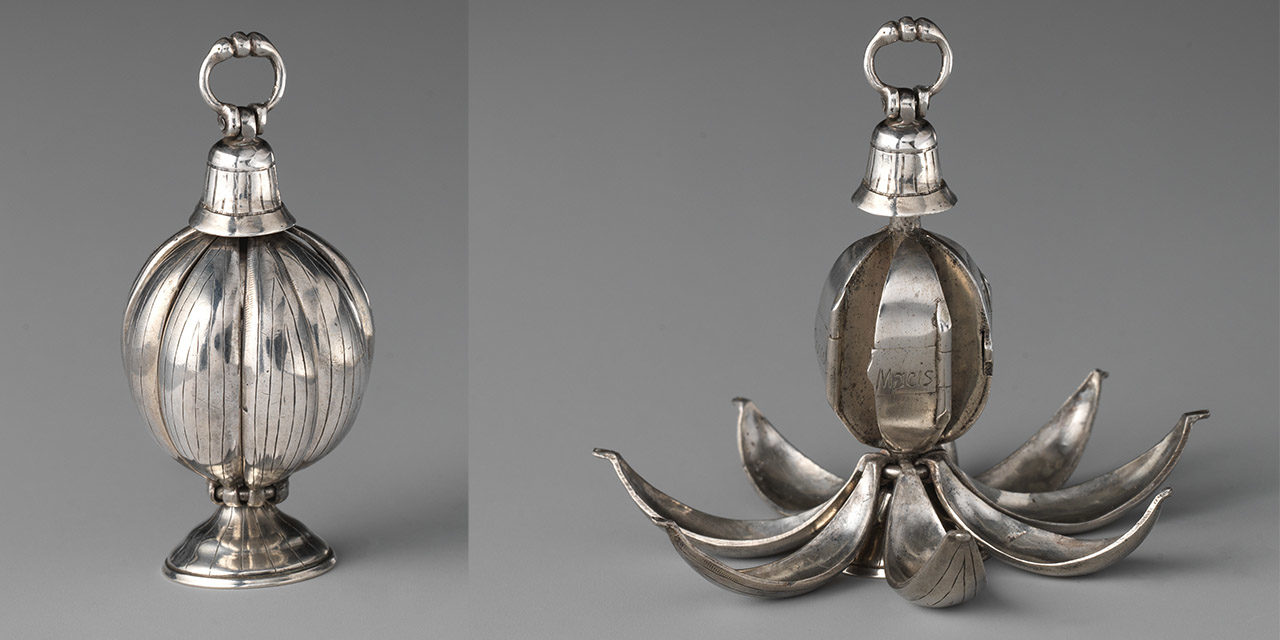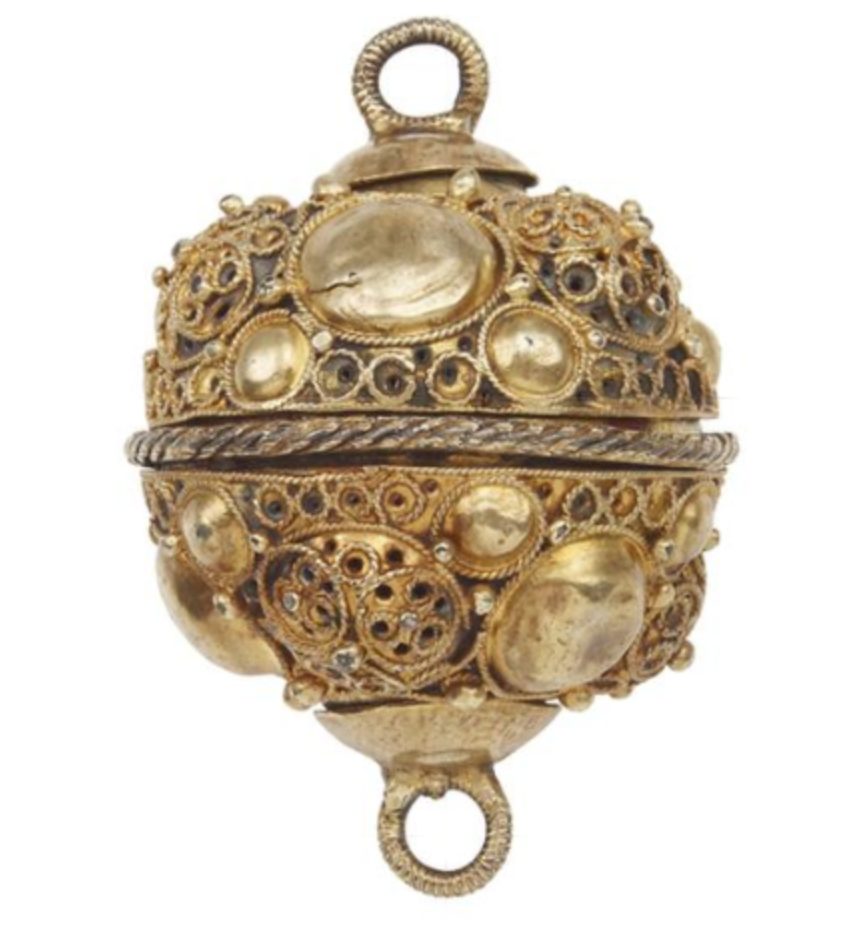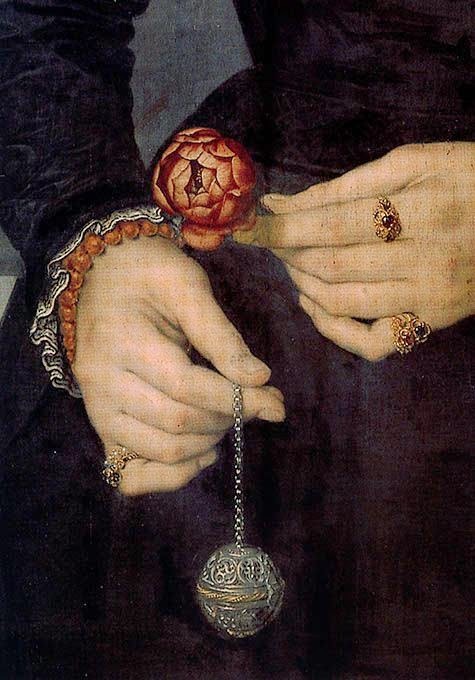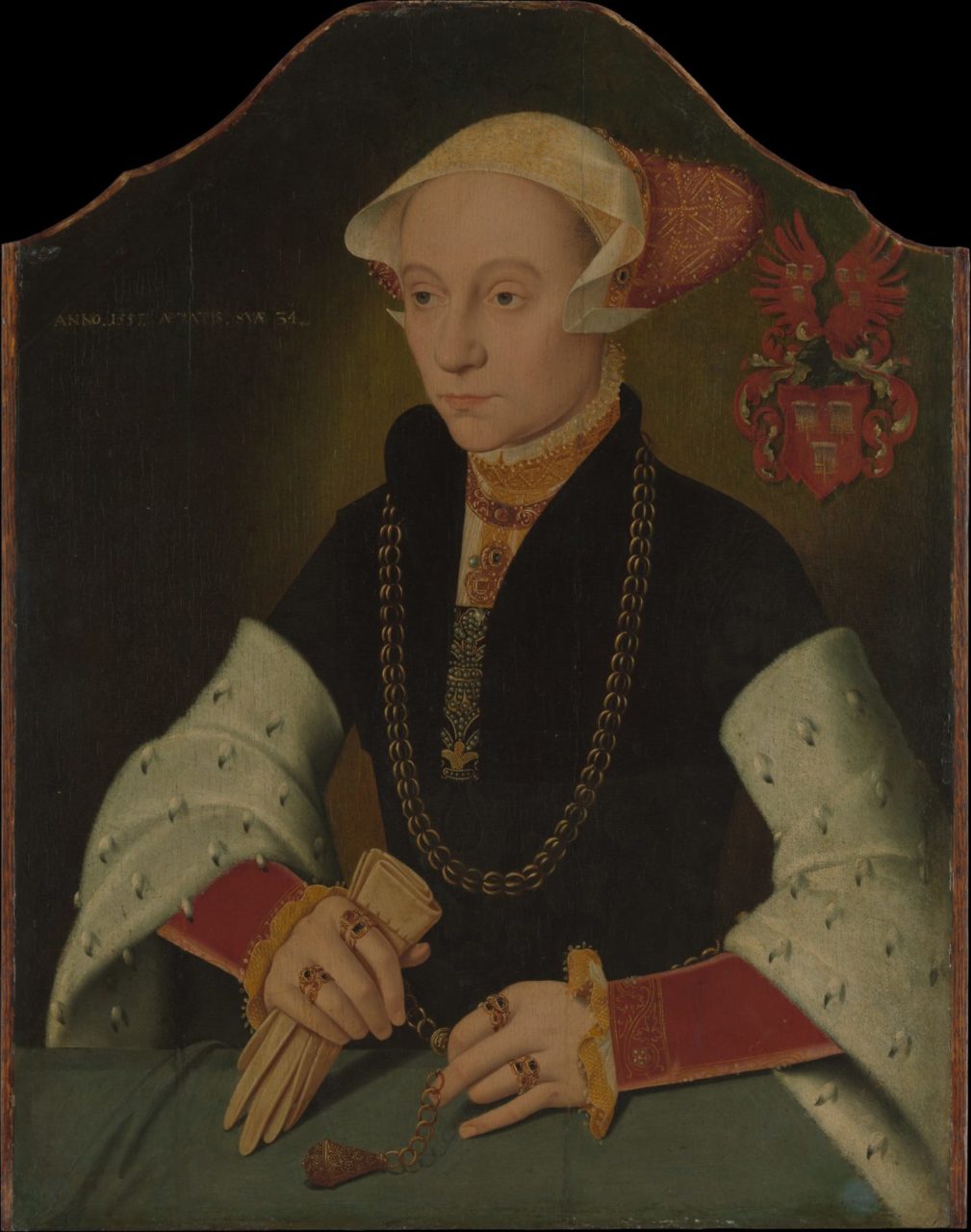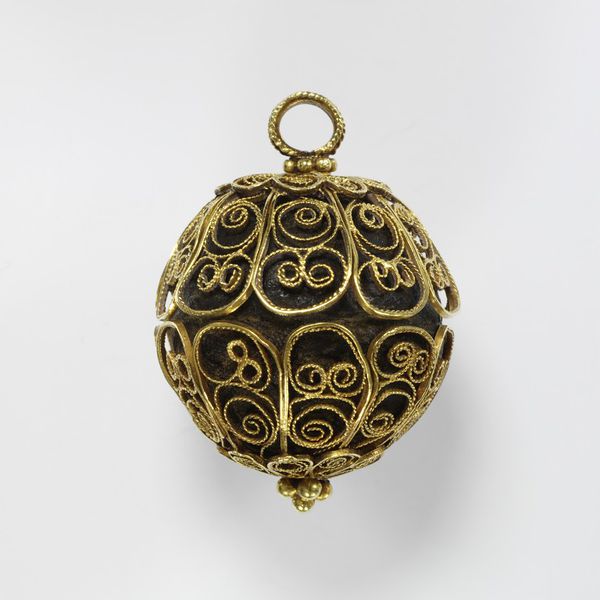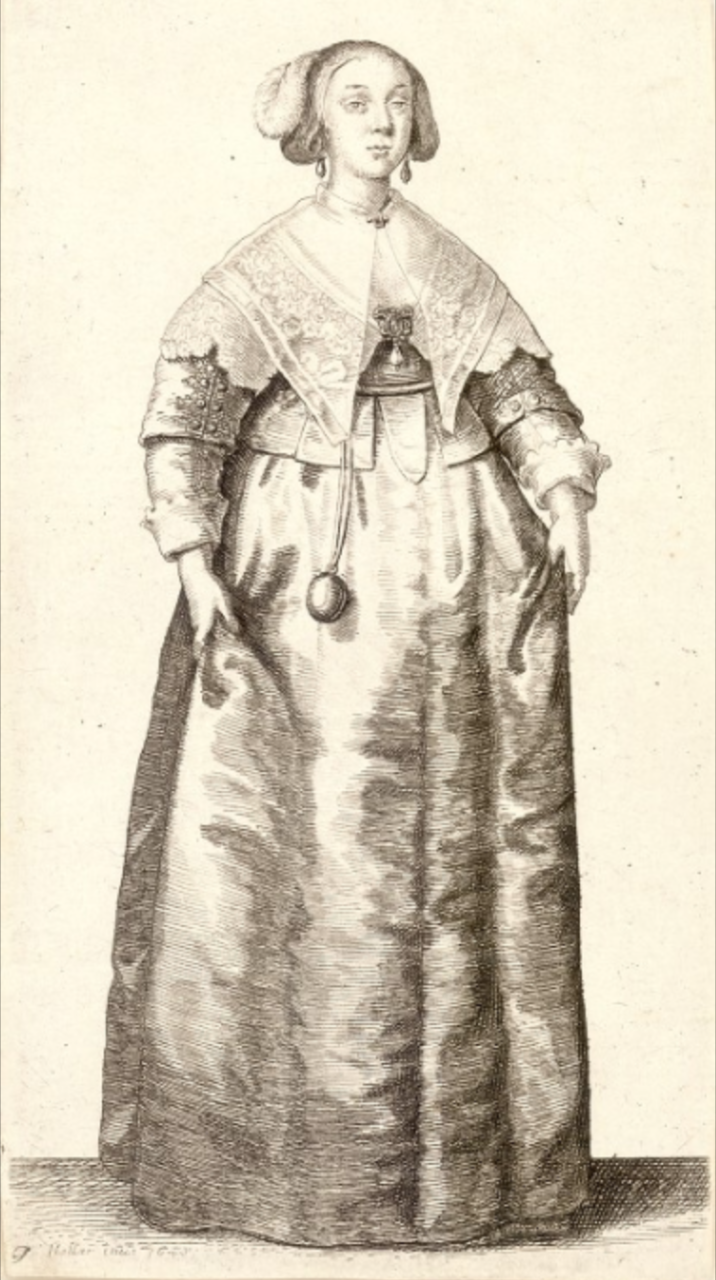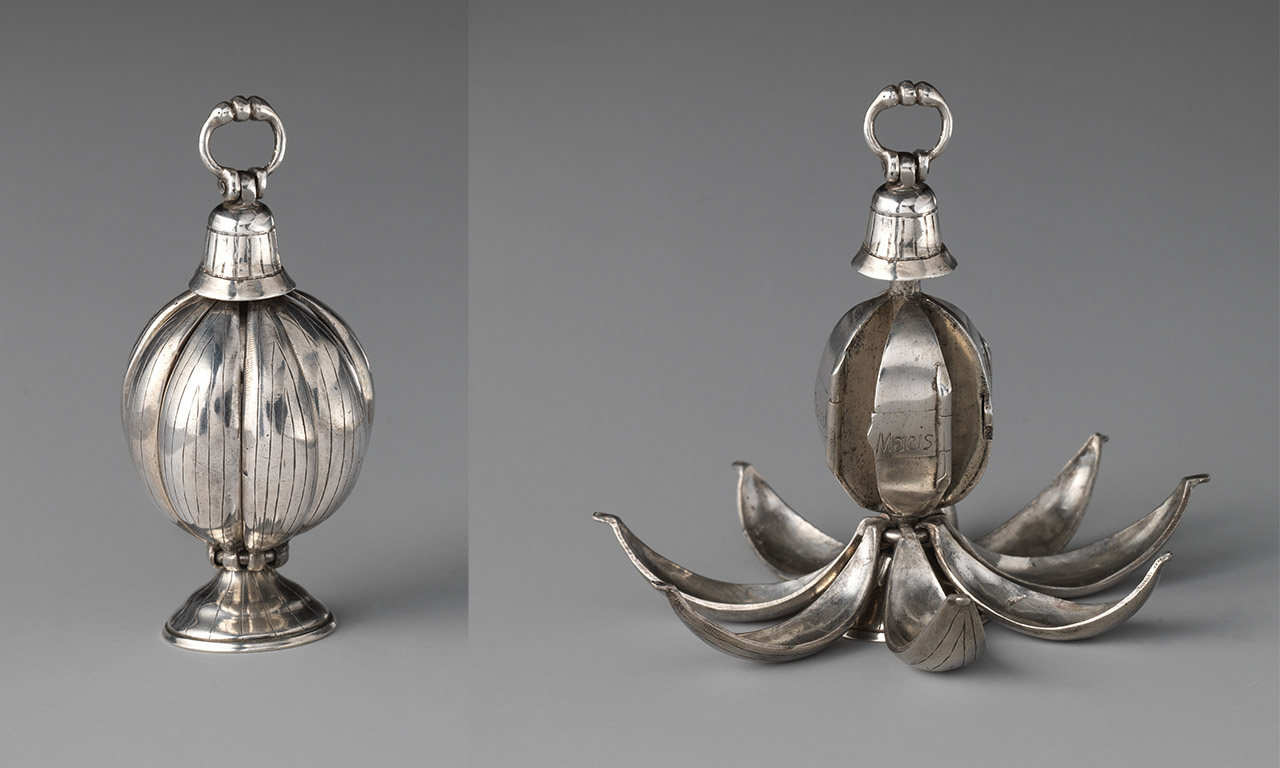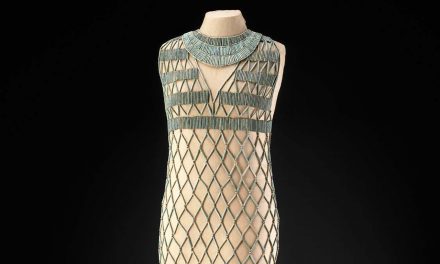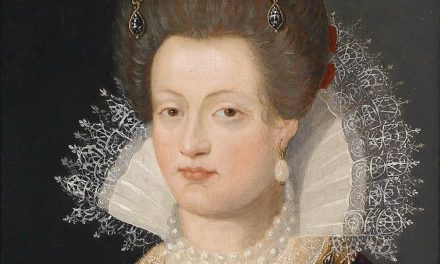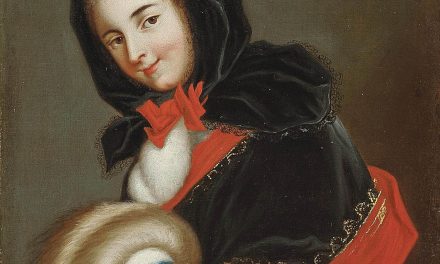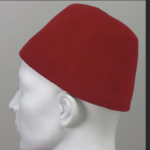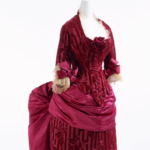A small metal ball filled with perfumed items worn in the 16th & 17th centuries to create a pleasant aroma.
The Details
Charlotte Mankey Calasibetta and Phyllis Tortora in the Dictionary of Fashion (2003) define the pomander as:
“a ball of fragrant herbs and/or flowers or the case in which these were carried. Examples of pomanders include pommes de senteur, small balls of gold or silver filigree set with precious stones used to hold scent, carried or hung from belt from 1500-1690s (also called musk apples, pound-box, musk balls, and pouncet box, consisting of a dry-scent box that contained fragrant herbs and flower petals and was carried during the late 16th c. Der. French, ‘perfumed apples.'” (374)
A classic example of the pomander in gilded silver can be seen in figure 1. A woman in a 1550 Nicholas Neufchâtel portrait carries just such a pomander (Fig. 2).
Joan Nunn in Fashion in Costume 1200-1980 (1984) further describes how it was worn:
“carried or hung from the girdle from 1500 and 1690, were small perforated receptacles of goldsmithing, either circular and flat or spherical, containing perfume or sweet herbs thought to protect against infection and helpful in warding off unpleasant smells.” (49)
Examples of just such fine goldsmithing can be seen in the 1557 Barthel Bruyn the Younger portrait of a woman in the Met’s collection (Fig. 3) and in a surviving pomander filled with ambergris in the V&A’s collection (Fig. 4).
Valerie Cumming in The Dictionary of Fashion History (2010) writes:
“A receptacle made of goldsmith’s work, containing perfume or ingredients thought to protect against infection. The form was usually a circular, flat box or ball-shaped, with perforations. The pomander was suspended from the girdle in front. A variety of recipes for the contents were in use and these were loosely known as “pomanders”, e.g. “make a pomander under this maner …” (1542, A. Boorde, Dyetary of Helth). Pomanders were occasionally carried by fops.”
Personal grooming and appearance were extremely important to both men and women of the time. Great care was taken into hairstyles, makeup, clothing, and accessories, however bathing was uncommon. In the sixteenth century, people believed they could contract disease if washed with water, hence the attractiveness of the pomander as an accessory.
Sara Pendergast and Tom Pendergast in “Sixteenth-Century Body Decorations” (2004) write:
“One of the most unique fashion accessories was the pomander, a metal or gold ball that contained perfume and was attached to the belt with a cord or tie. Many women of the time are pictured holding the pomander near their nose, perhaps to ward off the smells of body odor that must have filled the air.”
In Wenceslaus Hollar’s 1667 costume engraving, we see a woman wearing a pomander (Fig. 5). Daniel Delis Hill in the History of World Costume and Fashion (2011) says:
“In the late 1600s, the pomander ball was revived from the Middle Ages. Perfumed pieces of fabric, porous wood, or even locks of hair were inserted into tiny hollow containers that were pierced with decorative perforations.” (414)
The Met has a 17th-century Italian silver pomander with the hollow containers that Hill describes (Fig. 6).
Fig. 1 - Artist unknown (German). Gilded silver pomander, ca. 1501-1515. Gold, silver; 5 cm. Cologne: Museum für Angewandte Kunst, Inv.-Nr. G 911 CL. Source: Museum für Angewandte Kunst
Fig. 2 - Nicholas Neufchâtel (Flemish, 1527-1590). Portrait de Femme, ca. 1550. Oil on oak; 89.5 x 73 cm. Brussels: Musées royaux des Beaux-Arts de Belgique, Inv. 4507. Source: Musées royaux des Beaux-Arts de Belgique
Fig. 3 - Barthel Bruyn the Younger (German, ca. 1530–before 1610). Portrait of a Woman of the Slosgin Family of Cologne, 1557. Oil on oak; 45.1 x 35.9 cm (17 3/4 x 14 1/8 in). New York: The Metropolitan Museum of Art, 32.100.50. The Friedsam Collection, Bequest of Michael Friedsam, 1931. Source: The Met
Fig. 4 - Artist unknown. Gold filigree enclosing a ball of ambergris, 1600-1700. Gold; 4.1 x 2.9 cm. London: Victoria & Albert Museum, 849-1892. Given by Miss E. Mackworth Dolben. Source: V&A
Fig. 5 - Wenceslaus Hollar (Bohemian, 1607-1677). Lady with pomander, 1667. Engraving; 12 x 7 cm. Toronto: University of Toronto, P1786. Source: Univ. of Toronto
Fig. 6 - Artist unknown (Italian). Pomander, 17th century. Silver; 6.4 × 2.9 cm (2 1/2 × 1 1/8 in). New York: The Metropolitan Museum of Art, 20.67. Gift of Mrs. Arthur Curtis James, 1920. Source: The Met
References:
- Calasibetta, Charlotte Mankey, Phyllis G. Tortora, Charlotte Mankey Calasibetta, and Publications Fairchild. The Fairchild Dictionary of Fashion. 3rd ed. New York: Fairchild Publications, 2003. http://www.worldcat.org/oclc/959132362.
- Cumming, Valerie, C. W. Cunnington, and P. E. Cunnington. “Pomander.” in The Dictionary of Fashion History, 162. Oxford: Berg Publishers, 2010. Accessed September 28, 2016. https://www.bloomsburyfashioncentral.com/products/berg-fashion-library/dictionary/the-dictionary-of-fashion-history/pomander
- Hill, Daniel Delis. History of World Costume and Fashion. Upper Saddle River, NJ: Pearson Prentice Hall, 2011. http://www.worldcat.org/oclc/768100950.
- Nunn, Joan. Fashion in Costume, 1200-2000. 2nd ed. Chicago: Ivan R. Dee, 2000. http://www.worldcat.org/oclc/232125801.
- “Sixteenth-Century Body Decorations.” In Fashion, Costume, and Culture: Clothing, Headwear, Body Decorations, and Footwear through the Ages, edited by Sara Pendergast and Tom Pendergast, 493-496. Vol. 3, European Culture from the Renaissance to the Modern Era. Detroit: UXL, 2004. Gale Virtual Reference Library (accessed August 15, 2018). http://libproxy.fitsuny.edu:2540/apps/doc/CX3425500307/GVRL?u=fitsuny&sid=GVRL&xid=6e6c415b.

